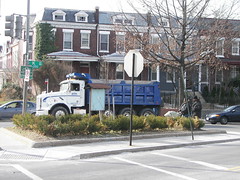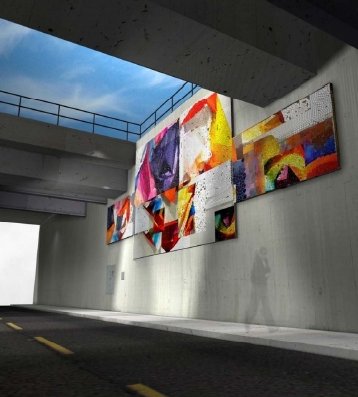Public art, civic engagement and civic opprobrium

Proposed sculpture in Adams Morgan, artist's rendering (via Washington City Paper).
The City Paper reports that a public sculpture project in Adams-Morgan was scuttled due to public opposition, in "How Listserv Fury, and a Rat, Helped Adams Morgan Lose a $250000 Arts Grant."
Frankly, I don't blame the opposition. The sculpture concept didn't impress me, as it was pretty cartoony, not much different than the fiberglass sculpture "public art" campaigns of cows, donkeys, etc., which many artists complain aren't really art, but a cartoonish idea of what art is.
Federal Reservation at 8th, K, and West Virginia Ave. NE.
Flickr photo by Kaptain Krispy Kreme.
Ironically, one of the very first civic projects I was involved in, back in 2001, was about bringing public art to a little sliver of triangle at the intersection of 8th Street NE, K Street NE, and West Virginia Avenue. While the community was engaged in the project, an obstreperous ANC commissioner, who saw the project as the vanguard of gentrification I guess, got the project scuttled over the need for a public space permit, and the piece of land still languishes today.
However, I have to say that given the artist project that the DC Commission on Arts and the Humanities picked for the site, some kind of sculpture not dissimilar from Soviet heroic realism, I wasn't totally upset that this project, that I worked hard on, didn't go forward. Meanwhile, a different public art project resulting from the same program, was installed at Maury Elementary School.
These kinds of reactions demonstrate that the DCCAH needs to do a much better job, both with the "art" side of such projects as well as the civic engagement side.
It happens that there is an interesting workshop on public art and tourism, that might have some relevance to this topic, although it's in Leeds in the UK, so I am not likely to go...
From email:
The Centre for Tourism and Cultural Change is pleased to announce the following forthcoming one-day Workshop that might be of interest to you:
art.public.tourism.
21 May 2010
Old School Board, Boardroom
Calverley Street, LS1 3ED, Leeds
Artwork is now often used in place marketing, but does public art attract tourists? Do artists share a language with destination managers? How can artists, art managers, destination managers and tourism promoters work together? Is what is good for art also good for tourism? And what kind of publics do art and tourism produce?
There are questions to be asked about the role of art as utilitarian objects or live events: should art be useful? What is use in relation to art? What makes art public? And how do we articulate the importance of the extra-ordinary in our experience of public spaces? Should tourism be a concern for artists, or should art be a concern for tourism? In a time of tighter public spending, how should tourism managers be thinking about and working with publics, artists and art?
The Workshop will be of interest to professionals working in arts management and regional development; destination managers at local and regional level; tourism development organisation and consultant; owners and managers of tourism sites as well as artists.
The questions that the workshop will consider, especially these two:
- Is what is good for art also good for tourism?
- what kind of publics do art and tourism produce?
seem to be important ones.
In the case of the DCCAH public art program and civic engagement in DC, I'd revise the questions some:
- are public art projects good for art?
- what kind of publics do public art projects produce?
- what kind of public art projects work best in "neighborhood settings"? ... in neighborhood settings that are also consumed by publics other than residents, e.g., Adams-Morgan is experienced-consumed-"oversampled" by visitors to the region, and other segments of the in-region population such as the Hispanic population?
- how do we engage citizens in the public process for public art projects?
Oh, in Takoma, there is a mural project for the Metro station. It was a public process too, that seems to have been relatively smooth. (I am pretty much unable to directly participate in much of anything anymore, so I didn't get involved.) See the press release on the project that was decided.
Rendering, Sam Gilliam mural, Takoma Metro Station
Labels: civic engagement, provision of public services, public art




0 Comments:
Post a Comment
<< Home